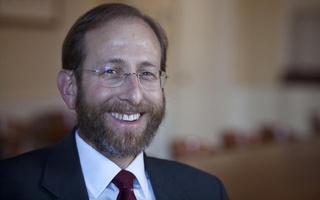“[Western Avenue} was going to be completely remade with culture and museums, and what we’re getting is some pizza and a bakery some day,” says Harry E. Mattison, a member of the Harvard Allston Task Force.
THE ROAD AHEAD
While Allston may not be a cultural center for the University in the immediate future, there is renewed discussion about bringing Harvard’s sciences across the river. As the economy stabilizes and Harvard’s endowment regains its strength, the University once again sets its sights on Allston. Hyman says that he is “quite hopeful” that there will be “active Harvard academic programs” in Allston in the next ten to fifteen years, suggesting that the construction project will see resurrection, though perhaps not in its original form. As the new provost, Garber’s job will be to bring vision and vigor to Harvard’s plans for development in Allston, taking the lead from Hyman, a man who has seen years of dreams deferred in the neighborhood.
“I oversaw the development of the academic plan for the Allston Science Complex, and my greatest disappointment as provost is that a plan I believed in, because of changes to the economy, had to go on ice,” says Hyman who was provost under Summers when the project was first announced and has overseen academic planning at the University for the past decade. “At times, I just felt defeated by the financial reality. It certainly caused me to reflect on the possibility that the physical plan was grander than perhaps we needed for the academic plan,” Hyman adds, who—like Garber—is a physician and researcher by training.
Hyman’s tenure represents the longest in the history of the position, which was created 19 years ago. He has endured the tumultuous end of Summers’ presidency, the transition to Faust, and the devastating effects of the financial crisis. In order to succeed in Allston, Hyman notes that Garber must make the project his own.
“In the end Alan is going to have to own the academic plan because if Allston is going to be a success it’s going to have to bring together, just within the science part, FAS, Harvard Medical School, the School of Public Health and, ideally, the Business School,” Hyman says.
Garber is cognizant of the role the provost must play in bringing together different disciplines from across the University as the administration considers its path forward in Allston.
“In the case of Allston, the challenge is not only to figure out which disciplines would benefit from the facilities located in Allston, but also to predict where synergies might occur,” Garber writes in an email. “In other words, we need to understand how the pieces will fit together, assessing the potential for unexpected and productive collaborations.”
Garber will not be without help in developing a viable academic vision for the University in Allston. For the past year and a half, Executive Vice President Katherine N. Lapp has overseen the Allston Work Team, a 14-person group of deans, alumni, and faculty commissioned by Faust to asses Harvard’s presence in the neighborhood and develop recommendations for how to proceed. The results of their findings will be available to the community in June, according to the group’s co-chair Bill Purcell, though neither he nor Lapp would comment on the shape the recommendations will take or the nature of their content.
“[Garber] will certainly be very much in the mix in terms of understanding what kind of activities and interdisciplinary opportunities exist,” says Lapp, noting that she, personally, has briefed him on the main issues around the University’s development in Allston. “We make sure he has as much information as possible,” she adds.
Lapp, whose past titles include executive director of the Metropolitan Transit Authority in New York City and executive vice president for business operations at the University of California, comes to the puzzle of Harvard’s expansion in Allston from a business and urban development perspective and has used that knowledge to collaborate with Work Team’s chairs, who have differing areas of expertise.
Purcell, a former mayor of Nashville, was the director of the Institute of Politics until April 2010, when he stepped down to devote more time to developing the Work Team’s recommendations. Purcell has a long history of witnessing the tensions that arise from University expansion.
Growing up in Philadelphia, Purcell has noted that he experienced first hand the University of Pennsylvania’s contentious development into its surrounding neighborhoods, a past he says he brings to bear in his current work. Purcell holds monthly coffee hours intended to allow Allston residents to express concerns; the last will take place this June, when the Work Team’s recommendations are released.
Working alongside Purcell are Business School Professor Peter Tufano ’79 and Graduate School of Design Professor Alex Krieger, who were chosen to bring different perspectives to the process.
Christine M. Heenan, vice president for public affairs and communication, notes that Garber’s foundation in science will be useful in evaluating and implementing the Work Team’s recommendations.
Read more in News
Renaissance EngineeringRecommended Articles
-
 Stanford Professor Alan M. Garber ’76 Selected as Next Provost
Stanford Professor Alan M. Garber ’76 Selected as Next Provost -
 Professors Confident in New Provost
Professors Confident in New Provost -
Hyman Leads Stanley CenterPrior to becoming director of the Center, Hyman served as director of the National Institute of Mental Health in the 1990s, which helped fuel his interest in the problems posed by serious mental illnesses.
-
 The Fall of Academics at Harvard
The Fall of Academics at Harvard -
Students To Vote on Reintroducing American Sign Language CoursesStarting on April 21, undergraduates will be able to vote on whether or not to support the reintroduction of American Sign Language courses that may be taken for credit.
-
 Sign Language Referendum Passes Easily Amid Low Voter Turnout
Sign Language Referendum Passes Easily Amid Low Voter Turnout













